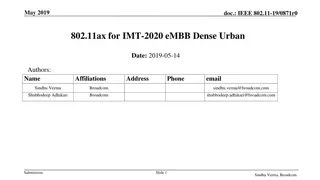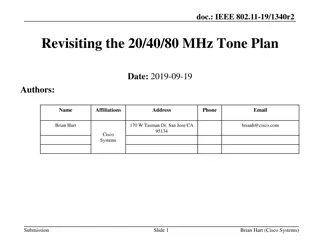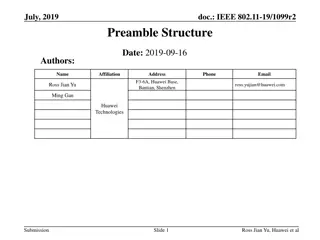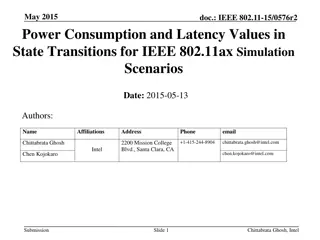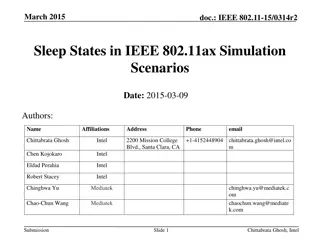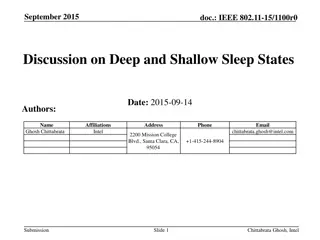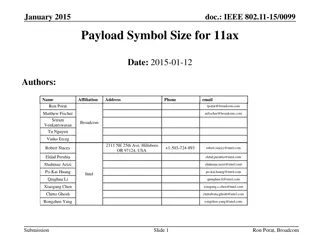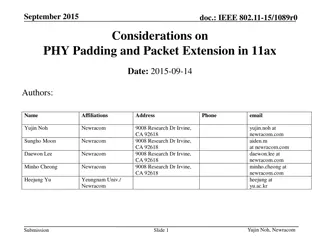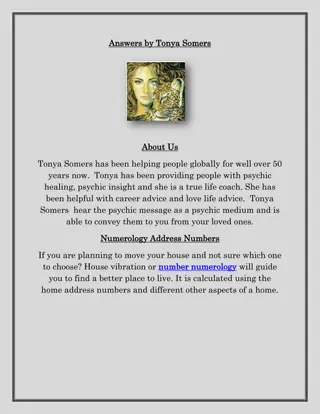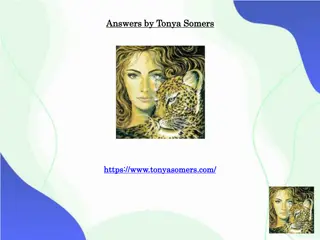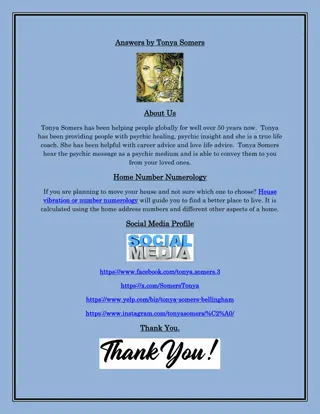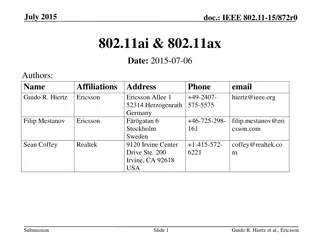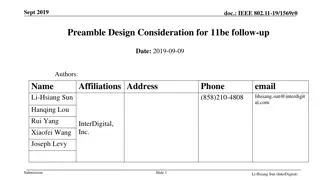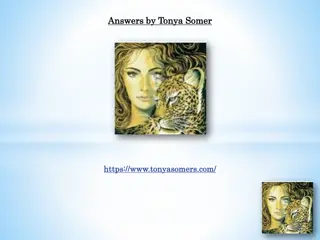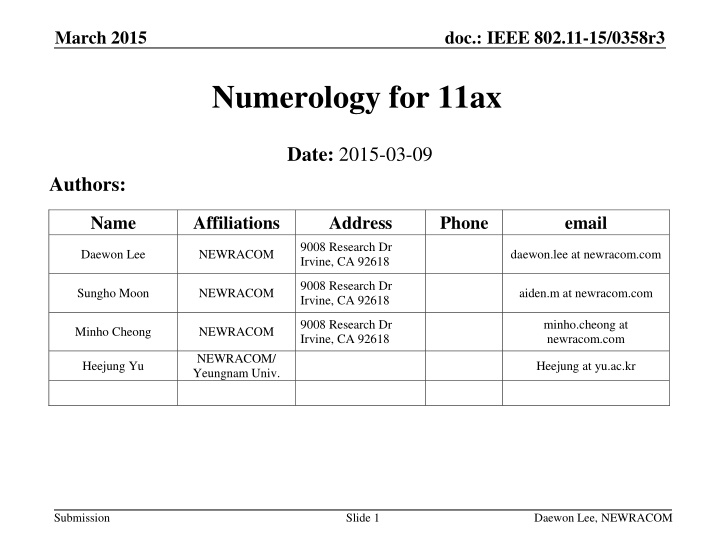
Numerology for IEEE 802.11-15/0358r3 in March 2015
Dive into the detailed exploration of numerology in the IEEE 802.11 standard revision 15 document from March 2015. Topics covered include available tones, frequency resource allocation granularity, user diversity gain, DC tones, and proposed numerology baselines for 20MHz bandwidth. Learn about the implications of subcarrier spacing, bandwidth division, user distribution, and more. Gain insights into the design considerations for efficient OFDMA implementation.
Download Presentation

Please find below an Image/Link to download the presentation.
The content on the website is provided AS IS for your information and personal use only. It may not be sold, licensed, or shared on other websites without obtaining consent from the author. If you encounter any issues during the download, it is possible that the publisher has removed the file from their server.
You are allowed to download the files provided on this website for personal or commercial use, subject to the condition that they are used lawfully. All files are the property of their respective owners.
The content on the website is provided AS IS for your information and personal use only. It may not be sold, licensed, or shared on other websites without obtaining consent from the author.
E N D
Presentation Transcript
March 2015 doc.: IEEE 802.11-15/0358r3 Numerology for 11ax Date: 2015-03-09 Authors: Name Affiliations Address Phone email 9008 Research Dr Irvine, CA 92618 Daewon Lee NEWRACOM daewon.lee at newracom.com 9008 Research Dr Irvine, CA 92618 Sungho Moon NEWRACOM aiden.m at newracom.com 9008 Research Dr Irvine, CA 92618 minho.cheong at newracom.com Minho Cheong NEWRACOM NEWRACOM/ Yeungnam Univ. Heejung Yu Heejung at yu.ac.kr Submission Slide 1 Daewon Lee, NEWRACOM
March 2015 doc.: IEEE 802.11-15/0358r3 Number of Available Tones As an example in [1], number of available tones was discussed for 78.125kHz subcarrier spacing. It was shown that up to 230 subcarriers (excluding a single DC tone) can be used and power spectral mask can be met. Submission Slide 2 Daewon Lee, NEWRACOM
March 2015 doc.: IEEE 802.11-15/0358r3 Frequency Resource Allocation Granularity for OFDMA Depending on the frequency resource granularity for OFDMA, e.g. 1.25 MHz, 2.5 MHz, etc, we will need to divide up 20/40/80/160 MHz into several bandwidth chunks. For example, support of 5 MHz resource granularity may require the total number of available tones in a OFDM symbol to be divisible by 4. Therefore, 230 tones should not be chosen for this case. The following is a table of number of tones candidate in 20 MHz # of Tones in 20 MHz 1.25 MHz (divide by 16) 2 MHz 2.5 MHz (divide by 8) 4 MHz (divide by 5) 5 MHz (divide by 4) 10 MHz (divide by 2) (divide by 10) 230 NO YES NO YES NO YES 228 NO NO NO NO YES YES 226 NO NO NO NO NO YES 224 YES NO YES NO YES YES 222 NO NO NO NO NO YES Submission Slide 3 Daewon Lee, NEWRACOM
March 2015 doc.: IEEE 802.11-15/0358r3 User Diversity Gain TGac D ITU NLOS UMi Gain over 20MHz 10 MHz: 1.1% 5 MHz: 2.4% 2.5 MHz: 3.5% 1.25 MHz: 4.0% Gain over 20MHz 10 MHz: 5.6% 5 MHz: 11.1% 2.5 MHz: 16.6% 1.25 MHz: 21.3% Frequency selectivity gain simulations No MAC protocol overhead assumed (just pure comparison of user diversity gain) 1 AP, and maximum of 8 STAs in OFDMA STAs are uniformly distributed in 25m / 250m radius Non-continuous resource allocation was allowed Submission Slide 4 Daewon Lee, NEWRACOM
March 2015 doc.: IEEE 802.11-15/0358r3 Number of DC Tones in 20MHz Number of DC tones in the 12.8us OFDM symbols will depend on the residual frequency offset after CFO compensation from the preamble. According to 11ac studies [2], residual CFO std. deviation is between 0.07 ~ 0.13 ppm (depending on the integrated phase noise assumption) in indoor channel models of the highest SNR regime. Unless residual CFO is larger than of the subcarrier spacing (i.e 7.8 ppm in 5GHz), a single DC tone should be sufficient. Note that this does not necessary mean we should only have 1 DC tone. Further simulation check on outdoor environments and in low SNR regime will be needed to determine the number of DC tones. Submission Slide 5 Daewon Lee, NEWRACOM
March 2015 doc.: IEEE 802.11-15/0358r3 Proposed Numerology Baseline for 20 MHz Choice of frequency resource granularity depends on signaling complexity/overhead system performance Granularity below approximately 2 ~ 2.5 MHz is not necessary Suggested Candidates for 20 MHz Option 1) 230 data/pilot tones, 1 DC tone, and (13 + 12) Guard tones Option 2) 228 data/pilot tones, 1 DC tone, and (14 + 13) Guard tones Option 3) 228 data/pilot tones, 3 DC tone, and (13 + 12) Guard tones Option 4) 224 data/pilot tones, 1 DC tone, and (16 + 15) Guard tones Option 5) 224 data/pilot tones, 3 DC tone, and (15 + 14) Guard tones Option 6) 224 data/pilot tones, 5 DC tone, and (14 + 13) Guard tones Submission Slide 6 Daewon Lee, NEWRACOM
March 2015 doc.: IEEE 802.11-15/0358r3 Expansion to 40/80 MHz Alternative 1 Direct multiplication of 20 MHz No further optimization to use the guard subcarriers between bands Ease to scale sub-channel definitions for OFDMA Unused 40 MHz Guard Band Gap: Approximately 2 MHz of spectrum 5.6% of potential capacity for 40 MHz 8.3% of potential capacity for 80 MHz 20 MHz 20 MHz Alternative 2 Optimized to use all available spectrum sub-channel definitions for OFDMA becomes complicated 40 MHz Submission Slide 7 Daewon Lee, NEWRACOM
March 2015 doc.: IEEE 802.11-15/0358r3 Example of Alternative 1 - based on option 4 - Data + pilot 112 20MHz Right Guard Tone 15 +112 +1 -1 -112 56 Data + pilot 224 40MHz -16 +16 +240 -240 56 Data + pilot 448 80MHz -16 +16 +496 +240 +272 -272 -240 -496 56 Left Guard Tone 16 Submission Slide 8 Daewon Lee, NEWRACOM
March 2015 doc.: IEEE 802.11-15/0358r3 Example of Alternative 2 - based on option 4 - Data + pilot 112 20MHz Right Guard Tone 15 +112 +1 -1 -112 56 Data + pilot 240 40MHz +1 -1 +240 -240 60 Data + pilot 496 80MHz -1 +1 +496 -496 62 Left Guard Tone 16 Submission Slide 9 Daewon Lee, NEWRACOM
March 2015 doc.: IEEE 802.11-15/0358r3 Numerology Baseline for 40/80 MHz The majority of the OFDMA is likely stem from protocol enhancement for MU transmissions. Only 2~20% user diversity gain from ideal situations. Therefore, it may be very important to support STAs operating in different operating bandwidth (for power saving reasons) Maximum spectral efficient gains is available only when each user is SINR saturated (i.e. maximum MCS). Maximum spectral efficiency gains for Alternative 2 is around 6% ~ 11%. Actual gains depends on the number of pilots vs data tones. The power of each tone is normalized, slightly small number of tone usage result in higher transmit power spectrum density for each tone. The cost of complexity in designing OFDMA systems that can scale between 20 MHz ~ 160 MHz seems to be far more important than SE gains in SINR saturated scenarios, which is not the main target for TGax. Submission Slide 10 Daewon Lee, NEWRACOM
March 2015 doc.: IEEE 802.11-15/0358r3 Numerology for 160 MHz Given that 11ac supports 80+80 MHz, where the 80 MHz chunks can be discontinuous in frequency, 11ax should also support 80+80 MHz operations. To avoid numerous implementation options, we propose to 160 MHz numerology as two 80 MHz operations (same design method as in 11ac) This allows the use of the same power spectral mask definitions DC Tones (not available for data) 160 MHz 80 MHz 80 MHz Submission Slide 11 Daewon Lee, NEWRACOM
March 2015 doc.: IEEE 802.11-15/0358r3 Straw Poll #1 Do you agree to add to the TG specification framework document? x.y.z. The 40 MHz HE PPDU numerology (i.e. number of data and pilot tones, DC tone, and guard tones) is defined by aggregating two 20MHz HE PPDU numerology in frequency. YES NO ABS Submission Slide 12 Daewon Lee, NEWRACOM
March 2015 doc.: IEEE 802.11-15/0358r3 Straw Poll #2 Do you agree to add to the TG specification framework document? x.y.z. The 80 MHz HE PPDU numerology (i.e. number of data and pilot tones, DC tone, and guard tones) is defined by aggregating four 20MHz HE PPDU numerology in frequency. YES NO ABS Submission Slide 13 Daewon Lee, NEWRACOM
March 2015 doc.: IEEE 802.11-15/0358r3 Straw Poll #3 Do you agree to add to the TG specification framework document? x.y.z The 20MHz HE PPDU numerology is defined by [230, 228, or 224] usable (i.e. data or pilot) tones with [1, 3, or 5] DC tones. Note that TGax will down select later among the numbers in brackets. YES NO ABS Submission Slide 14 Daewon Lee, NEWRACOM
March 2015 doc.: IEEE 802.11-15/0358r3 Straw Poll #4 Do you agree to add to the TG specification framework document? x.y.z. The 160 MHz HE PPDU numerology (i.e. number of data and pilot tones, DC tone, and guard tones) is defined by aggregating two 80MHz HE PPDU numerology in frequency. YES NO ABS Submission Slide 15 Daewon Lee, NEWRACOM
March 2015 doc.: IEEE 802.11-15/0358r3 References [1] Daewon Lee, et. al., OFDM Numerology for 11ax IEEE 802.11-15/0079r1 [2] Kai Shi, et. al., Phase Tracking During VHT-LTF IEEE 802.11-10/0771r1 Submission Slide 16 Daewon Lee, NEWRACOM

